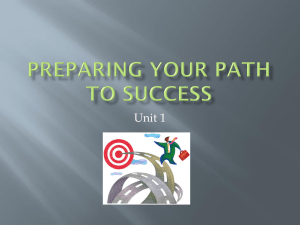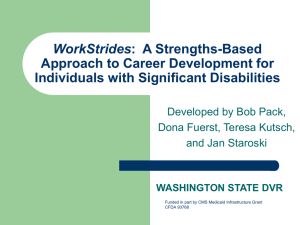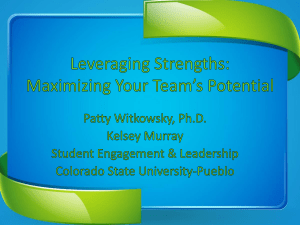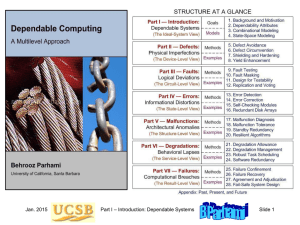Skills Identification - Center on Education and Work
advertisement
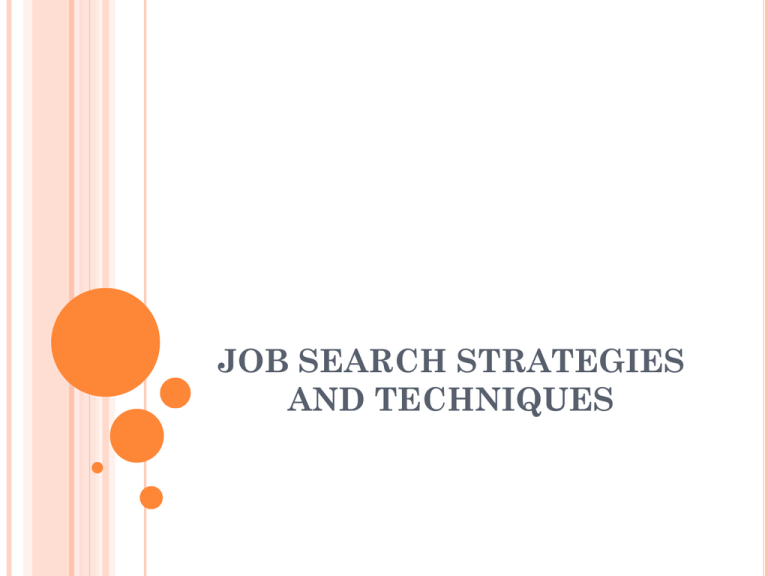
JOB SEARCH STRATEGIES AND TECHNIQUES “NETWORKING” INTRODUCTIONS SHARE the following 1. 2. 3. Your Name Something about your work that you’re excited about – a goal, a project, or an element of your work you find especially satisfying An objective for this workshop – what do you hope to learn or gain? LISTEN for ways to assist your colleagues 1. 2. In meeting objectives for the workshop In achieving their work goals Steps to a Successful Job Search •Interests •Personality Characteristics •Skills & Strengths •Values 1. Information about Self •Research 2. Information Jobs about Options Occupations Career Fields •Education Required •Making Connections •Weigh Pros/Cons •Evaluate Match •Choose •Review 3. Decision Making Adapted from UW Professional Organizational Development, Susan Templeton 4. Taking Action •Resources •Apply •Interview •Follow Up STEPS TO A SUCCESSFUL JOB SEARCH 1. 2. 3. 4. Realistic Career/Vocational Choice Define Competencies (Skills/Strengths) Determine Target Market Position Statement Dick Gaither, Wizards of Work 5. Identify Targeted Companies 6. Develop Marketing Tools 7. Project Activity Plan 8. Implement Plan SKILLS IDENTIFICATION Or You’re a nice person, now what can you do? SKILLS TRIANGLE SKILLS TRIANGLE Transferable Skills Transferable Skills are common to a number of jobs and can be adapted to a particular employer's need. Job Content Skills Job Content Skills are related to job-specific tools and tasks. They usually have a vocabulary of their own. SELF-MANAGEMENT SKILLS Self-Management Skills are personality traits which help an employer decide if your temperament suits a particular job. They are clues to how well you may adapt to situations and solve problems. These are most important because very few employers offer training in these areas. Development of these skills is an individual initiative. TRANSFERABLE SKILLS Write Clearly Listen Organize Tasks Train File Records Handle Money Gather Information Teach Others JOB CONTENT SKILLS Data relates to numbers of any kind (percentages, frequency, and money) People include what kind of people you work with (co-workers, customers, vendors, etc.) and what you do with, for, or to each of them. Things refer to tools, machines, or pieces of equipment you know how to use. Ideas are suggestions you came up with to make the job easier, more efficient, or more profitable. SELF-MANAGEMENT SKILLS Honest Enthusiastic Responsible Dependable Dedicated o Adaptive o Creative o Energetic o Sincere o Conscientious DETERMINING SKILLS & STRENGTHS Formal Skills Assessments Checklists Informal Assessments / Activities PERSONAL BRANDING WITH SKILLS AND STRENGTHS Dependable Strengths Dynamic Natural Abilities Core Genius Reflected Best Self Unique Gifts DEPENDABLE STRENGTHS® There is Excellence in Everyone No one is good at everything…. But everyone is good at something. 9 DOTS l l l l l l l l l Copyright, Bernard Haldane, Dependable Strengths Institute WHAT ARE YOUR 9 DOTS? Things we tell ourselves or others tell us. Assumptions Expectations Cover Words What are the implications? DEPENDABLE STRENGTHS® PHILOSOPHY There is excellence in everyone. Excellence is demonstrated through achievement (Good Experiences). By studying a number of Good Experiences, recurring themes or patterns can be identified. Everyone has their own unique combination of Dependable Strengths. More is accomplished by building on strengths than trying to improve weaknesses. Copyright, Bernard Haldane, Dependable Strengths Institute DSAP ASSUMES People are active participants in determining what happens in their lives Healthy individuals participate in communities; therefore, they engage others in the process of selfdiscovery Copyright, Bernard Haldane, Dependable Strengths Institute HOW DO WE DISCOVER STRENGTHS? By Remembering and Talking About Good Experiences “GOOD EXPERIENCE” Something you DID: You feel you did well You enjoyed doing You are proud of Demonstration • Listen • Record • Share Copyright, Bernard Haldane, Dependable Strengths Institute INSTRUCTIONS 1. 2. 3. 4. 5. Appoint a timekeeper so everyone will have enough time and select someone to go first. That person will share 2-3 good experiences (5-6 minutes) and tell what they did to make it happen. Remaining group members: Listen Write down skills/talents you think the person used. You can ask questions about how and what they did to make it happen – but no WHY questions. Feedback: After the first person has shared, everyone in the group should give feedback. Make eye contact. Say, ‘You demonstrated…” (1-2 min) Give the completed strength sheets to the person. Repeat the process until everyone has a turn. Copyright, Bernard Haldane, Dependable Strengths Institute PROOF BY EXAMPLE 1. Identify the Skills Handle Money (cashier, retail sales, bank teller) 2. Present a Concrete Example Describe where and for how long you used this skill: “One year of experience at XYZ Department Store.” 3. Qualify Example: Describe Circumstances who, what when, whey, how “Assisted approximately 100 customers per day – calculated costs – processed credit card and cash payments.” PROOF BY EXAMPLE 4. Reinforce with Measurable Data numbers, dollars, percentages, volume per month, year, etc. “Handled approximately $3,000 per day - $750,000 per year.” 5. Give Results…What Happened? How did the company benefit from your skill? “Accomplished monetary transactions with the lowest error rate of any employee. Received only two complaints that year. After six months was promoted to Senior Cashier.” PROOF BY EXAMPLE Using your top three skills from previous lists, imagine yourself as the employer. How will you determine if hiring the person with that skill would…. increase profits? decrease turnover? improve productivity? COMMONLY SOUGHT SKILLS – THE BIG 5 1. 2. 3. 4. 5. Communication Skills Interpersonal Skills Teamwork Skills Leadership Skills Computer/info technology Skills ADDITIONAL IN-DEMAND SKILLS Adaptability/flexibility Skills Problem-Solving Skills Organizational Skills Analytical Skills Quantitative Skills WHAT SKILLS DO EMPLOYERS WANT? Communication Skills Computer Skills Customer Service Skills Team-Working, Flexibility Practical and Technical Skills Motivation Quality Control / Attention to Detail Learning Skills Problem-Solving Skills OKAY, I KNOW MY SKILLS – HOW AND WHERE DO I PUT THEM TO WORK? WHAT IS YOUR TARGET MARKET? Geographic Area Specific Industry and / or Specific Type / Size Business Specific Job Title Or field / area Ultimately Determine Target Companies LEARNING ABOUT POTENTIAL EMPLOYERS Business Model Why are they in business? How do they do what they do? What do they offer? Vision / Goals Values / Corporate Culture Competition FINDING EMPLOYER INFORMATION General Labor Market State LMI Sites Databases available through Career Centers Specific Employer Information Glassdoor.com Careerleak.com Google Alerts Hoovers – www.hoovers.com $$ Chamber Lists JOB SEARCH METHODS What are ways to look for jobs? JOB SEARCH STRATEGIES & ELEMENTS Networking Responding to Ads / Postings Newspaper, other print materials Online job boards Job Fairs Direct Mail Campaigns Job Placement / Career Centers Staffing Agencies / Search Consultants / Recruiters OTHER JOB SEARCH ELEMENTS Researching Companies, Industries, Job Opportunities Preparing Representational Materials Resumes, Cover Letters, Portfolio, Skills Cards/Bio Sheet Interviewing Goal Setting and Tracking Job Search Efforts Follow-Up Writing Thank-You notes Following up with network members But it’s a tough economy! FUNDAMENTAL TRUTHS ABOUT JOB SEARCH COURTESY OF RICHARD BOLLES There are always jobs to be filled (vacancies) Finding jobs depends on your search methods If you’re “coming up empty,” try a new method NETWORKING Six Degrees of Separation Just how far are you from Kevin Bacon? Friend 3 – 20 people Friend 2 – 20 people Friend 1 – 20 people Friend 1 – 20 people Friend 2 – 20 people Friend 4 – 20 people Friend 5 – 20 people Friend Friend 2 – 203 – 20 peoplepeople Friend 1 – 20 people Friend B 20 people Friend 4 – 20 peopleFriend 5 – 20 people Friend A 20 people YOU 20 people Friend D 20 people Friend 3 – 20 people Friend 5 – 20 people Friend 4 – 20 people Friend 1 – 20 people Friend 2 – 20 people Friend 2 – 20 Friend people 3 – 20 people Friend C Friend 4 – 20 20 people Friend people 5 – 20 people Friend 1 – 20 people Friend E 20 people Friend 3 – 20 people Friend 4 – 20 people Friend 5 – 20 people Fully Mapped – 400 People; Next Level – 8,000 People!!! Your LinkedIn Network 33 Connections link you to 263,483+ professionals 4,307 New people in your Network since January 12 POSSIBLE NETWORKS Personal Relationships Professional Relationships Organizational & Community Connections Opportunistic Networks PURPOSES OF NETWORKING (RELATIONSHIP-BUILDING) Learn about career fields / options Get feedback on job search efforts / materials Form contacts in industry / companies of interest Discover job opportunities Connect with decision-makers Identify ways to assist / help others in network Ongoing professional support & development Experience support in the job search process BLUEPRINT FOR NETWORKING Identify potential networks Create your “elevator speech” (short pitch) Who are you? What is your passion / effort /direction? What are you seeking in the situation? Set goals for networking (x contacts per week, etc.) Track your networking efforts Follow up with your network Develop your networks before you need to look for a job NETWORKING ACTIVITY o o o Assume you have a client who wants to gain information about a specific job or in a particular field (on your laminated card) Network with other participants in the workshop to find contacts in your designated field Record contact information on an index card o o o o Record the name of the person who referred you Record the contact name Where the contact is located Try to secure at least 3 contacts for your client HOW DO I GET MY RESUME NOTICED??? RESUME TIPS Develop a master resume, but customize / target resumes for each job sought Point out key skills that align with the specific job Include relevant experience; not everything you have done needs to be included Include a professional email address Emphasize outcome, accomplishments, and breadth of responsibility; include quantifiable results whenever possible Aim for overall ease of reading and attractive format FINDING KEY WORDS FOR RESUME Review Job Description and identify key words Compare with other similar job descriptions in your group Note similar key words among the varied descriptions Identify the top 5 – 10 words found most often among the job descriptions KILLER RESUMES: Show you have job skills for the job Show you deliver results Show you can solve problems Show you can communicate effectively Show your capacity for leadership Remember, it’s about getting the interview! ACHIEVEMENT OR PROBLEM-ACTION-RESULT STATEMENTS SHOW HOW YOU HELP A COMPANY Make money Save money Save time Improve a process Reverse an existing problem Be first to market Build relationships/brand identity Grow the business Attract new business Maintain existing business INTERVIEWING SKILLS Selling Yourself for the Job You Want PURPOSE OF JOB SEARCH ACTIVITIES, NETWORKING, RESUME WRITING, ETC? A foot in the door So you can get An INTERVIEW! INTERVIEWING IS A PERFORMANCE STEPS FOR INTERVIEWING 1. 2. 3. 4. Know Yourself Know Your Audience Tell a Great Story Be Inquisitive For all of these think from employer / business owner perspective Adapted from J.T. O’Donnell – CareerRealism.com and David Muir – Prepare to be Hired SO, TELL ME ABOUT YOURSELF . . . . •Keep it short •Keep it professional •Not your life history •Not a chronology of everything you’ve ever done at work RESPONDING TO “TELL ME ABOUT YOURSELF” – CRAFTING YOUR PITCH What key skills /strengths do you have that you love to use (show your passion) How do these skills positively impact an employer (make or save money) Give an example from your experience to demonstrate / prove (use strong accomplishments) Explain your interest in using those skills for the employer Adapted from J.T. O’Donnell, Richard Bolles, David Muir PRACTICE FOR THE PERFORMANCE CRAFTING YOUR PITCH Develop your opening pitch Share in groups Provide feedback / constructive criticism WHAT ABOUT THE ELEVATOR SPEECH OR 15 SECOND PITCH? Pitch Wizard My name is _______________________________ I am a(n) _________________________________ Specializing in ____________________________ What you do ______________________________ __________________________________________ Why you’re the best _______________________ __________________________________________ You’re call to action _______________________ __________________________________________ Total of less than 500 characters for entire statement PITCH WIZARD www.15secondpitch.com DISCUSSION How can we engage our customers in developing a “pitch”? What activities / approaches would help them with this process? BEHAVIORAL INTERVIEWING Tell me about a time when you . . . . PRACTICE FOR THE PERFORMANCE Articulating Skills I am _________, __________, and ___________ BASIC FORMAT WORKS AS A STARTER FOR MANY QUESTIONS Tell me about yourself . . . Why should I hire you? Why are you interested in this job? If you ask my co-workers about me, they will tell you I am _________, __________, and __________ If you look at my performance evaluations, you can see that I am __________, __________ , and ___________ TAKE A “CAR” TO THE INTERVIEW Context Action Result This was the situation This is what I did (using my skill) This was the outcome (quantify whenever possible – how can you make or save money?) THREE “REAL ANSWERS” EMPLOYERS ARE LOOKING FOR IN AN INTERVIEW Can Use your CAR to show your skills & experience Will you do the job? you love the job? Speak with enthusiasm and energy; be passionate about what have done / can do Will you fit in with the manager and team? Build rapport with interviewer; show ability to align with corporate culture PRACTICE FOR THE PERFORMANCE Examine interview questions How can we encourage customers to think through and write out answers to each of these questions? REVIEW – PREPPING FOR THE INTERVIEW 1. Know Yourself Your Strengths, Skills, & Assets 2. Know Your Audience Do your homework Learn about the company & the interviewer 3. Tell a Great Story Give me a skill & tell me a story Demonstrate how your skills make a positive impact for the employer Be enthusiastic and energetic REVIEW - CONTINUED **4. Articulate Experience +Learn =Grow What have you learned from your experiences that improve the workplace? How will your experience contribute positively to the new workplace? Enthusiasm, energy, passion 5. Be inquisitive Ask questions to connect with the interviewer, Ask questions that show you’ve done your research & that you’re interested in the company and the process PRACTICE, PRACTICE, PRACTICE Remember ..... Preparation Plus Practice Prevents Poor Performance! ADDITIONAL RESOURCES What Color is Your Parachute? - Richard Bolles No One is Unemployable – Debra Angel & Elisabeth Harney www.rileyguide.com www.quintcareers.com www.job-hunt.org www.asktheheadhunter.com www.careerealism.com www.theladders.com www.brazencareerist.com www.jobstar.org www.indeed.com Windie Wilson Assistant Director Workforce Connections P.O. Box 51650 Knoxville, TN 37950-1650 windie.wilson@knoxcac.org 865 544-5200
